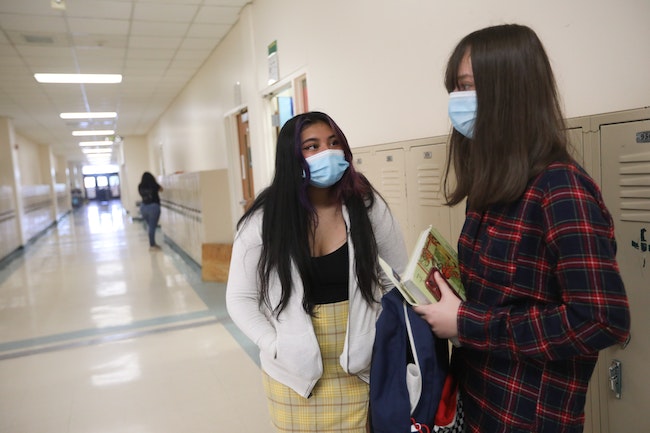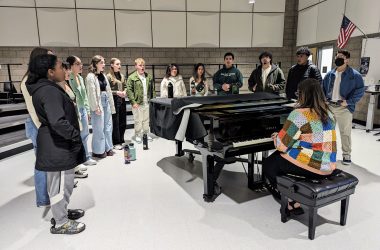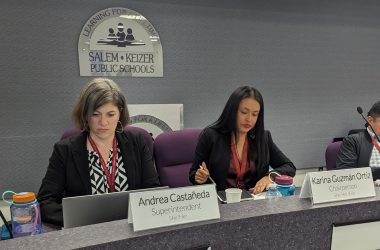 Miranda Lara Ruiz, 16, left, and Marina Melnychuk pick up items from their lockers at McKay High School on Thursday, September 3. (Amanda Loman/Salem Reporter)
Miranda Lara Ruiz, 16, left, and Marina Melnychuk pick up items from their lockers at McKay High School on Thursday, September 3. (Amanda Loman/Salem Reporter)
Oregon so far has little picture of how hundreds of thousands of students are faring with virtual learning this year but local experience in Salem indicates gaps are emerging along predictable lines.
Nearly one month into the school year, 93% of nearly 42,000 students registered in the Salem-Keizer School District are showing up to school each day, about the same as in the first three weeks of last school year when classes were operating normally.
That figure omits the first days of school when all students were automatically marked present because of technical issues with district-issued Chromebooks and software.
But attendance numbers now don’t mean what they did when students showed up in schools. Under current state rules, teachers mark a student as attending if they have any contact with an educator in a 24-hour period.
That means a student turning in an assignment or emailing a teacher to ask for help counts as attending class for the day. The attendance records don’t reflect how much time a student actually spends learning.
Teachers and administrators said that the modern attendance numbers less accurately capture whether students are showing up to class and learning.
“That’s a starting point,” said Iton Udosenata, assistant superintendent for local middle and high schools. “That can’t be our sole indicator that we’re using.”
Still, the limited data reveals some categories of students are faring better than others.
Homeless students are showing up about 91% of the time, compared with 94% for the first three weeks of last school year. Pacific Islander and Native American students are posting the lowest attendance rates of any district racial or ethnic group, at 91% and 92% respectively.
There’s variation between schools as well. Those with more low-income students are generally reporting lower attendance.
For the district’s high schools, attendance ranges from a daily average of 83% at McKay to 95% at West Salem.
And about 700 students have appeared at half or fewer days of school.
Across the district, teachers and principals said they’re working overtime to try to reach struggling families and get them logged in.
Internet access remains a persistent issue, said Tom Charboneau, principal of Gubser Elementary School in Keizer.
“A lot of our families are struggling to be able to facilitate that,” he said.
Teachers first try to call or contact a family if the student isn’t showing up regularly, Charboneau said. If that doesn’t work, they’ll bring in other school employees like the counselor or instructional mentor to help.
“Teachers are really working to try to problem solve and be creative and think outside the box as far as how can I reach this family, how can I reach this student,” he said.
Charboneau said he’s served as the “home coach” for some schools. That’s a daily window in the evening where school employees are by phone to talk to parents and help them troubleshoot problems.
He recently spoke to a family whose student spent time at a child care center with inadequate internet service. The district arranged for the family to get its own “hotspot” for web access.
That extra outreach is adding hours onto the already long workdays of teachers and principals, he said.
“It’s all new. We’re trying to keep our noses above water. There’s so much information and things coming at us,” he said.
Udosenata said with the district decision last week to keep school all online through at least Feb. 1, the urgency to connect with families is greater.
“We really need to focus our attention and energy in making sure kids don’t fall through the cracks. We know that it’s happening and we know that it’s happening with our most vulnerable,” he said.
Udosenata said principals have a system for flagging students they’re unable to reach. At high schools, employees like graduation coaches or mentors go to homes to find students and determine what is the issue.
“For some it’s access to technology. For some it’s competing obligations at home, especially around responsibilities like childcare,” he said.
Some students just don’t know where to start with online classes and need a push. Others may have language barriers to using software.
North Salem High School has done about 45 home visits this year, Udosenata said. The district is hiring more employees who can do those visits as part of a spending plan the Salem-Keizer School Board approved last week.
But Udosenata said engaging students who struggle is more challenging when everything is online.
“Pre-Covid if a student was chronically absent there were still touchpoints,” he said.
Those kids would show up at school, at least occasionally, giving school employees a chance to learn what was going on at home.
Some local schools have started small in-person classes for students struggling the most online.
Under state Covid restrictions, schools can allow kids into buildings for up to two hours per day in groups of 10 or fewer students to meet academic needs that can’t be met remotely. That option is available for all schools.
The district hopes to have such classes at every school by late November, said assistant superintendent Kraig Sproles. Such classes are intended to be in addition to the virtual classes.
Scott Nine, assistant superintendent for Oregon’s Office of Education Innovation and Improvement, said the state is hearing that distance learning is going better than in the spring.
The state is insisting schools be more rigorous about seeing students are attending, but hasn’t been regularly monitoring the record. State education officials don’t expect to have a good handle on the issue until early next year.
Nine said school districts, not the state, are responsible to track attendance and act when gaps develop.
The state will examine district reports in November to see whether gaps among categories of students are emerging or worsening under distance learning. That analysis could lead to new instructions to schools.
For now, Nine said the state is responding to requests for help from districts and meeting regularly with superintendents and educational service district leaders to assess how things are going.
SUPPORT ESSENTIAL REPORTING FOR SALEM – A subscription starts at $5 a month for around-the-clock access to stories and email alerts sent directly to you. Your support matters. Go HERE.
Contact reporter Rachel Alexander: [email protected] or 503-575-1241.

Rachel Alexander is Salem Reporter’s managing editor. She joined Salem Reporter when it was founded in 2018 and covers city news, education, nonprofits and a little bit of everything else. She’s been a journalist in Oregon and Washington for a decade. Outside of work, she’s a skater and board member with Salem’s Cherry City Roller Derby and can often be found with her nose buried in a book.









